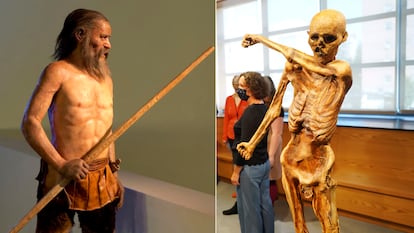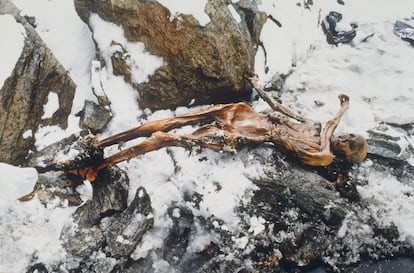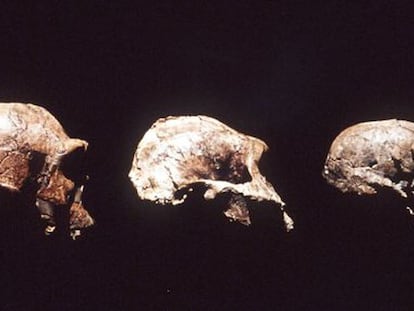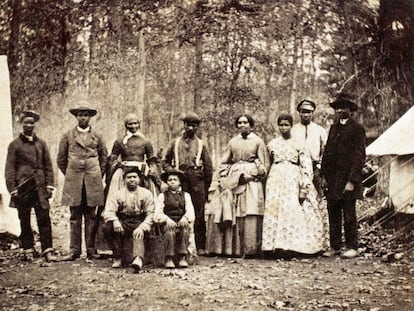Neither white nor long-haired: Ötzi the Iceman was bald and dark-skinned
A new sequencing of his genome has dismantled the image of the man, who was killed 5,300 years ago

A new genetic analysis of Ötzi, a man naturally mummified in the ice of the Alps, has redrawn the image of the most famous European Neolithic. According to this research, he was neither white, nor long haired, and he did not come from the east.
Discovered in 1991 by a pair of German mountaineers on a glacier, the mummified remains of Ötzi — who is also called Iceman — have been studied in detail, with researchers investigating how he was killed and the last thing he ate. A decade ago, Ötzi’s complete genome was sequenced for the first time. And with that data and some imagination, he was made to appear more like a character from a movie about prehistoric times than what he actually looked like. Now, a new genetic study has found that he was probably bald, with dark skin and that his ancestors were farmers who came from Anatolia, present-day Turkey.
In 2012, the results of the first analysis of Ötzi’s nuclear DNA were published. To do this, researchers applied sequencing techniques available at the time to the left iliac (hip) bone. They were able to determine that he had brown eyes, that his blood group was 0 and that he was lactose intolerant, like the vast majority of Europeans at the time. They also connected him to his contemporaries, the inhabitants of the Tyrrhenian Sea coasts, current-day Corsica and Sardinia. As for his ancestors, the dominant genes came from the communities of the eastern Steppes. The research said nothing about his skin or hair color, but since then, the image of this prehistoric man has been of a fair-skinned, fair-haired adventurer or hunter.
The new work, published in the scientific journal Cell Genomics, uses the same bone to re-sequence Ötzi’s genome. But today’s technology is not the same as it was a decade ago. Johannes Krause, a researcher from the Max Planck Institute for Evolutionary Anthropology in Germany and lead author of the study, says we now have “a better understanding of what he looked like with the latest results.” He explains: “The Iceman was probably bald, had darker skin than most Europeans, and was not of Eastern European Steppe herder ancestry.” Men with his genetic variation go bald long before they reach old age.

When his remains were recovered from the ice, the mummy appeared to have dark skin, but it was always thought that it was the mummification process itself that had darkened Ötzi’s skin. “Much of the reconstruction could be more a figment of the artists’ imagination of a Central European from the past than the actual mummy,” says Krause. “We have discovered during the last decade that light skin only became massively widespread in the last 5,000 years, probably as an adaptation to agriculture. Eight thousand years ago, all Western and Central Europeans had dark skin.” In other words, Ötzi looked more like the mummy than had been accepted until now.
Being a farmer, or belonging to a community that worked the land, is also in the genes. Ötzi had a number of metabolism-related variations that set him apart from the Paleolithic hunter-gatherers. “There are variants in genes that are polymorphic in humans, where one variant provides better adaptation to a diet rich in animal fats [in Inuits, for example] and others are better at digesting vegetable fat. The Iceman had the latter. He was better adapted to a plant-based diet, which generally comes with an agricultural lifestyle,” Krause explains.
That plant-based diet and his agricultural lifestyle identify Ötzi as from the European Neolithic period. When he was killed by an arrow, between 5,373 and 5,143 years ago, the agricultural communities descended from the first farmers who came from Anatolia and the Near East were already pushing the hunter-gatherer groups into a corner or directly assimilating them. But in those centuries, peoples from the east, from horse-herding cultures such as the Yamnaya, also arrived, bringing their languages and their genes. Until the current migrations, the gene pool of Europeans was a mix of Anatolian, Steppe and a bit of hunter-gatherer. In the 2012 study, researchers believed they had found the genetic sign of Steppe herders. But, according to the new work, the identification was due to contamination of the sample with modern DNA.
Albert Zink is the director of the Institute for Mummy Study at Eurac Research, a group of research centers in Bolzano, Italy. The institute is located in Tyrol, the same city that is home to the museum where Ötzi is on display. Zink was the lead author of the 2012 paper that began providing an idea of what the Iceman looked like, and is also a co-author of Krause’s work. To explain the new image of Ötzi, Zink points out that researchers now have more data on population genetics and more prehistoric DNA, with which to compare the Iceman’s genes. “In 2012, there were only a few genomes. What’s more, we were able to reduce human contamination and thus clarify his ancestry, showing that he was not of Steppe origin.”

In fact, Ötzi was about as Anatolian as you could get. He shared 92% of his genome with the first European Neolithic farmers who began to arrive from that region some 9,000 years ago. This very high degree of ancestry at a time when the Steppe had already arrived in Europe, sometimes wiping out all genetic traces of the tribes who preceded them, shows a genetic isolation that can only be explained by the fact that the farmers lived in alpine valleys. It is logical to think that, given this isolation, their genome would contain traces of reduced genetic diversity and even of the inbreeding typical of isolated groups. But there is none of that in Ötzi.
“The absence of inbreeding could be explained by the fact that the alpine is not a completely isolated area,” explains Zink. “It was probably a sparsely populated area with little contact with other populations, but there was still the possibility of coming into contact with populations from other valleys, and it seems that they already crossed the Alps during the Neolithic. Moreover, we know that they had trade contacts with the Lake Garda region [near present-day Verona] and even with Tuscany. So they were not completely isolated, but there was isolation to a certain extent.”
Science is not finished with Ötzi. Just as researchers have been able to redraw his appearance and rethink his origin, they are now working with new techniques to learn about his microbiome and what the Iceman’s immune system was like.
Sign up for our weekly newsletter to get more English-language news coverage from EL PAÍS USA Edition
Tu suscripción se está usando en otro dispositivo
¿Quieres añadir otro usuario a tu suscripción?
Si continúas leyendo en este dispositivo, no se podrá leer en el otro.
FlechaTu suscripción se está usando en otro dispositivo y solo puedes acceder a EL PAÍS desde un dispositivo a la vez.
Si quieres compartir tu cuenta, cambia tu suscripción a la modalidad Premium, así podrás añadir otro usuario. Cada uno accederá con su propia cuenta de email, lo que os permitirá personalizar vuestra experiencia en EL PAÍS.
¿Tienes una suscripción de empresa? Accede aquí para contratar más cuentas.
En el caso de no saber quién está usando tu cuenta, te recomendamos cambiar tu contraseña aquí.
Si decides continuar compartiendo tu cuenta, este mensaje se mostrará en tu dispositivo y en el de la otra persona que está usando tu cuenta de forma indefinida, afectando a tu experiencia de lectura. Puedes consultar aquí los términos y condiciones de la suscripción digital.
More information
Archived In
Últimas noticias
Chris Martin, Taylor Swift, Elijah Wood and other famous wedding ‘crashers’
‘How does it feel to be a failure?’: Elizabeth Berkley’s journey from ‘Showgirls’ ridicule to vindication
The story of the Málaga virus: The code that haunted Google’s cybersecurity center director for 30 years
The impact of Ecuador’s mega-prison: A polluted river, cleared forests and military checkpoints
Most viewed
- Christian Louboutin: ‘Young people don’t want to be like their parents. And if their parents wear sneakers, they’re going to look for something else’
- The low-cost creative revolution: How technology is making art accessible to everyone
- Liset Menéndez de la Prida, neuroscientist: ‘It’s not normal to constantly seek pleasure; it’s important to be bored, to be calm’
- All the effects of gentrification in one corner of Mexico’s Colonia Roma
- December Social Security and SSI payments: Dates, double checks and the 2026 COLA increase











































